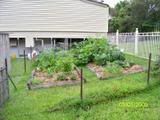
As much as I love my chickens - there are times when they have to go...
about 6 months ago we hatched out some chicks, and 2 were roosters. My poor girls have been struggling, with 3 roosters in the hen house - so some nutritious stock needed to be made. I love chicken stock made using the nourishing traditions
(http://www.fishpond.com.au/product_info.php?products_id=34643) recipe. In this book, Sally Fallon outlines the benefits of stock, saying that "properly prepared, meat stocks are extremely nutritious, containing the minerals of bone, cartilage, marrow and vegetables as electrolytes, in a from that is easy to assimilate. Acidic wine or vinegar added during cooking helps to draw minerals, particularly calcium, magnesium and potassium, into the broth."
So the recipe goes like this!
1 whole free-range chicken or chicken pieces
(chicken gizzards and feet can be used too)
4L cold filtered water
2 tbs vinegar
1 large onion, coarsely chopped
2 carrots, peeled and chopped
3 celery sticks, chopped
1 bunch parsely
I use the slow cooker, but I have also made it on the stove top. Place chicken into large stainless steel pot and cover with cold water, vinegar and vegies (except parsley). Let sit for 30-60mins. Bring to a boil and skim any scum from the top. Reduce heat, cover and simmer for 6 - 24 hours. The longer you cook the stock the richer and more flavourful it will be. About 10mins before finishing, add the parsley. This will impart more mineral ions into the broth.
Remove the chicken with a slotted spoon (you can use the meat for salads, sandwiches etc). Strain the stock into a large bowl and reserve in the refrigerator until the fat rises to the top and congeals. Skim off this fat and reserve the stock in covered containers in the refrigerator or freezer.
This stock is delicious and a perfect base for soups and casseroles in the winter. And my hens are much happier!








+169.jpg)